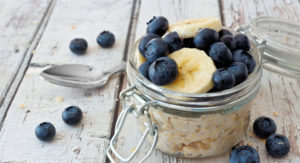 HYANNIS – What meal is the biggest pain for solo chefs? Breakfast gets my vote, especially on busy mornings.
HYANNIS – What meal is the biggest pain for solo chefs? Breakfast gets my vote, especially on busy mornings.
Cookbooks are full of luxurious ideas: Overnight French toast casseroles, grits soaking up country ham and eggs, fluffy buttermilk pancakes swimming in real maple syrup. Sure, like that’s going to happen on a work day. So, instead we grab a travel mug and a muffin. Or, worse, we head for the drive-thru.
We dismiss breakfast as a poor relation when we should be courting it like a rich uncle. Whether you’re the type who can eat as soon as you hop out of bed or need to wait awhile, it’s important to get something into a body that hasn’t had any nourishment for 10 or 12 hours.
“It only makes sense that we do eat breakfast and a good breakfast,” said Courtney Shea, MMHC RD LDN, the clinical nutrition manager for Cape Cod and Falmouth hospitals. “It helps you get your brain fueled, your body fueled.”
Breakfast is all about quality not quantity. A shot of caffeine and a blast of sugar from a muffin or donut will work briefly, but may result in a carb crash and the hungries by mid-morning. Instead, go for whole grains and protein.
You really want to think about what will sustain you through the morning,” Shea said. “Looking at the quality of the food you’re eating is important.”
Two quality foods – oatmeal and eggs – can be adapted to be quick and portable. Here’s how:
Oatmeal Three Ways
Shea, who has a husband and two kids and describes her mornings as a “circus,” likes the whole-grain nutrition of overnight oats – oatmeal that “cooks” in the fridge when it’s mixed with yogurt or milk. She makes it in containers she can grab on the way out the door. It’s more nutritious than instant oatmeal and sticks to your ribs longer, she said.
“I like it because I can just make it up Sunday for the entire week,” she said.
There are scores of overnight oat versions on the web but most use proportions of about twice as much liquid as oatmeal. So if you start with a ⅓ cup of oats, you need at least ⅔ cup of liquid. The liquid can be milk (any kind) or a mix of milk or water and yogurt. Stir it up in a bowl or jar and experiment with the proportions to get the consistency you like.
Shea throws in some banana or other fruit, chia seeds (for fiber) and sometimes powdered peanut butter, which is available in health food stores and aisles and easier to mix than regular peanut butter. You can add anything else you want: nuts, raisins or cranberries, cinnamon and other spices, even pumpkin puree. Shea likes it heavier on the yogurt so cuts back a bit on the oatmeal. Wait to add any nuts in the morning or they get soggy.
But, overnight oats aren’t for everyone. I think they look adorable in those glass canning jars but just taste like cold, gummy oatmeal. One solution: Zap them in the microwave for 40 or so seconds to warm them up before eating.
Or, if you have time to eat at home, you can cook one serving of traditional oatmeal in the microwave, just use a deep bowl and test the power level or you’ll have an oatmeal volcano worthy of a sixth-grade science project.
With my microwave, I dump about ⅓ cup oats and ⅔ cup water in a soup bowl and blast on half power for two minutes. Adding two or three tablespoons of liquid egg whites for the last 30 seconds makes the oats creamy and provides more protein. Or, try powdered or regular nut butter.
You can also cook oats in the slow cooker or instant pot and then rewarm them throughout the week. This is especially good with Irish or steel-cut oats, which take longer to cook. The recipe for one version is below.
Eggs two ways
Shea’s husband relies on another breakfast standby: eggs. “He boils a bunch and peels them all,” Shea said. “He grabs two or three in the a.m. … He’s on job sites. He doesn’t have access to space to eat, or condiments.”
There’s a more enjoyable way to make eggs portable: mini frittatas cooked in a muffin tin.
Beat a half dozen eggs (or the equivalent egg whites), adding salt and pepper, a couple of tablespoons of water and maybe a dash of hot sauce. That’s enough to fill 8 cups in a non-stick (VERY important) muffin tin about ½ full. Then, add a tablespoon or two of chopped spinach or other greens, cheese, ham or sausage, chopped sautéed onion and/or peppers – anything you might put in an omelet.
Bake at 350 degrees for about 12 minutes. Don’t overcook or they get rubbery. These will keep a few days in the fridge. You can eat them cold, or reheat them by microwaving for about 20 seconds.
Something Different
When my mother was a child, she would visit relatives in rural Tennessee where the big meal was at noon. Supper at night was leftovers from “dinner” and breakfast the next morning was even more leftovers, perhaps with a side of eggs or grits. The message: You can eat anything for breakfast. Hey, who among us has not grabbed a slice of cold pizza?
But there are more interesting and nutritional choices. For example, I cooked sweet potatoes for one of my breakfast-adverse kids. They “bake” in the microwave in five minutes or less and can be topped with a touch of maple syrup and butter, cheese or plain yogurt. Sweet potatoes are high in vitamins A and C and fiber.
Fish is a great alternative source of breakfast protein – just think outside the lox (sorry, couldn’t resist). In her cookbook “Bowls of Plenty,” Carolyn Carreñ has some great ideas for breakfast bowls. She builds one from ingredients that could be dinner leftovers: poached salmon, rice, cooked spinach. Start building with the rice, then the spinach. Add a sprinkle of sesame seeds and a drizzle of dressing such as the one below based on miso paste, a Japanese staple made from fermented soy beans. Then add on the salmon and maybe a poached or hard-boiled egg and some slices of avocado or pickled vegetables. That’s breakfast quality and quantity.
Recipes
Slow Oats
Steel-cut oatmeal works great for this and is so much more interesting than instant oatmeal. This amount takes four to six hours, so you can whip up a batch on a Sunday afternoon. You can also cut it down, but be sure to have enough liquid in the pot and keep an eye on cooking time.
This version is from “Slow Cooker Revolution” from America’s Test Kitchen. It calls for toasting the oats first, which is not necessary but adds flavor and texture.
• 2 tablespoons unsalted butter
• 2 cups steel-cut oats
• 8 cups water
• 1 cup raisins
• ½ cup brown sugar, or to taste
• 1 teaspoon ground cinnamon, or to taste
• 1 teaspoon salt
Melt butter in 12-inch skillet over medium heat. Add the oats and toast them, stirring constantly, until golden and fragrant, about 2 minutes. Transfer to slow cooker.
Stir water, raisins, sugar, cinnamon and salt into slow cooker. Cover and cook until oats are softened and thickened, 4 to 6 hours on low. Let sit for 10 minutes; stir well and serve, or put in airtight containers and keep in the fridge, ready to go or microwave. You can add hot water to adjust the consistency if necessary.
Sweet Miso Dressing
This recipe is from “Bowls of Plenty” by Carolyn Carreño, which has lots of great breakfast bowls. Miso has a salty, yeasty taste that conjures up many things, from chili to deviled eggs. Or, halve an eggplant, bake about 20 minutes or so until just tender, brush on this dressing and broil until bubbly. This makes about ¾ cup of dressing.
• cup sweet white miso
• ¼ cup rice vinegar
• 2 tablespoons mirin (Japanese sweet rice wine) or dry sherry
• 1 tablespoon sugar
• 1 teaspoon low-sodium soy sauce or tamari
• 1 teaspoon kosher salt
Whisk all the ingredients together in a small bowl until the dressing is smooth. It will keep refrigerated in a covered container for weeks.
























